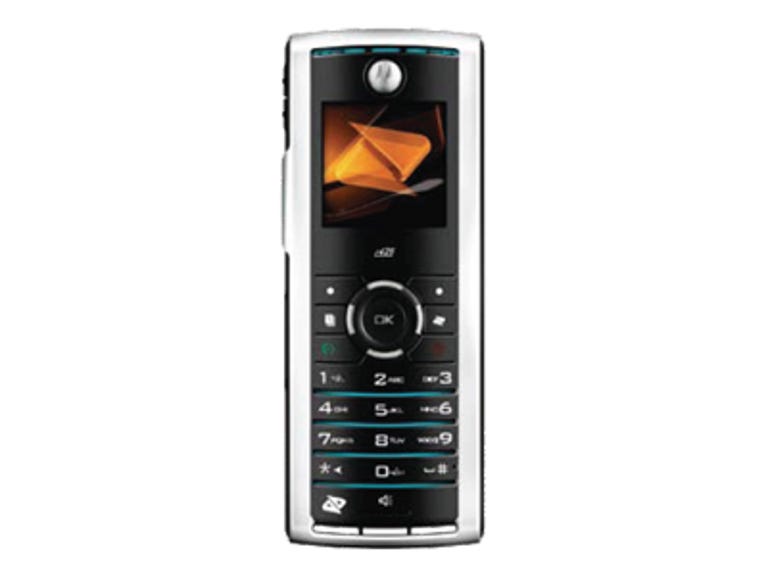It's not often that you see a thin iDEN cell phone. Sure, Nextel has its Motorola i335, but as a rule iDEN handsets tend to be big and bulky. Perhaps that's why Motorola and Boost Mobile, the youth-oriented MVNO that uses Nextel's network, felt the need to introduce the Motorola i425. Billed as the thinnest iDEN phone (it's just a hair's slimmer then the i335), the i425 casts a trim profile that should appeal to svelte phone fans. Its features are simple and are limited to a speakerphone and push-to-talk support; ultimately, this is a phone about making calls, which is something it accomplishes well. We had a couple of design complaints but on the whole, the i425 is a solid addition to Boost's lineup. You can get it for just $29 with service.
The Good
The Bad
The Bottom Line
Design
The i425 has an exceedingly simply design. As noted earlier, it's extremely thin (4.9 inches by 1.9 inches by 0.47 inch) but at 3.9 ounces it weighs a bit more than you might think. The i425 comes in white (the i425e) or titanium (the i425t) but the features are the same on both models. Though the handset fits comfortably in the hand, we didn't care for its construction. The plastic rear face felt rather flimsy and the method for accessing the battery was a bit awkward. Instead of removing just a portion of the rear face, you have to dig your fingernails under a seam at the bottom end of the phone and pry off the entire thing.

Like many iDEN phones, the i425's 1.5-inch display fails to impress. Though it supports 65,536 colors, the pixel resolution is rather low (130x130). As such, graphics weren't very sharp and colors were muted. Boost also incorporates the plodding multipage menu interface, which is so common on Nextel handsets. You can change the display's backlight time, the contrast, and the text size.

We weren't big fans of the navigation array and keypad buttons. All controls are covered in a cheap-feeling plastic material, which doesn't make them very tactile. What's more, the navigation buttons are rather squashed together and all keys are flat with the surface of the phone, which makes it difficult to dial by feel. There's a four-way toggle with a central OK button, two soft keys, a dedicated menu control, and the Talk and End/power keys. There's also a Web browser shortcut, and you can program the toggle to give one-touch access to four user-defined functions. The i425 also offers a dedicated speakerphone control below the keypad buttons. Though usually we approve of such a button, it's not in the best position. The backlighting in the keys is fine, though the Talk and End buttons are difficult to see in the dark.

The only remaining controls are a volume rocker and the PTT button on the left spine. Below them are a covered headset jack and a mini-USB/charger port. The side controls are well designed, and we had no problems finding them when during a conversation.
Features
As it's designed primarily to make calls, the i425 doesn't offer much in the features department. There's a 600-contact phone book with room in each entry for eight phone numbers (including a PTT number), an e-mail address, and an IP address. The i425 doesn't offer photo caller ID but you can pair contacts with one of 20 polyphonic ringtones (including one called "MySpace Freak"--whatever). Oh, and you can save your friends to groups.
Basic offerings include a vibrate mode, text and multimedia messaging, instant messaging, call timers, a memo pad, a speakerphone, a voice recorder, and a calendar. Voice dialing was an unexpected, but welcome addition, and the i425 is GPS-enabled.
You can personalize the i425 with a variety of wallpaper and color themes. You can download more options with the WAP Internet browser. A number of games and applications are at your disposal including BoostTV, Party Night Pimp, Hookt, World Series of Poker, and Hip Hop Immortal. You can buy more titles if you wish.
Performance
We tested the Motorola i425 in San Francisco. As an MVNO, Boost Mobile uses Nextel's network. Call quality was respectable for the most part. The volume level was quite loud and voices sounded natural. There was a slight echoed effect in some calls that made our friends sound as if they were far away. The echo wasn't annoying and it was only occasional. On their end, callers said we sounded fine and they didn't report any significant problems. Similarly, automated calling systems could understand us, even when we were outside. Speakerphone calls were fine, but we had to speak close to the phone to be heard.
The i425 has a rated battery life of 2.83 hours talk time and five days standby time. Our tests reveal a talk time of 3 hours and 2 minutes. According to the FCC, the i425 has a digital digital SAR rating of 1.35 watts per kilogram.



